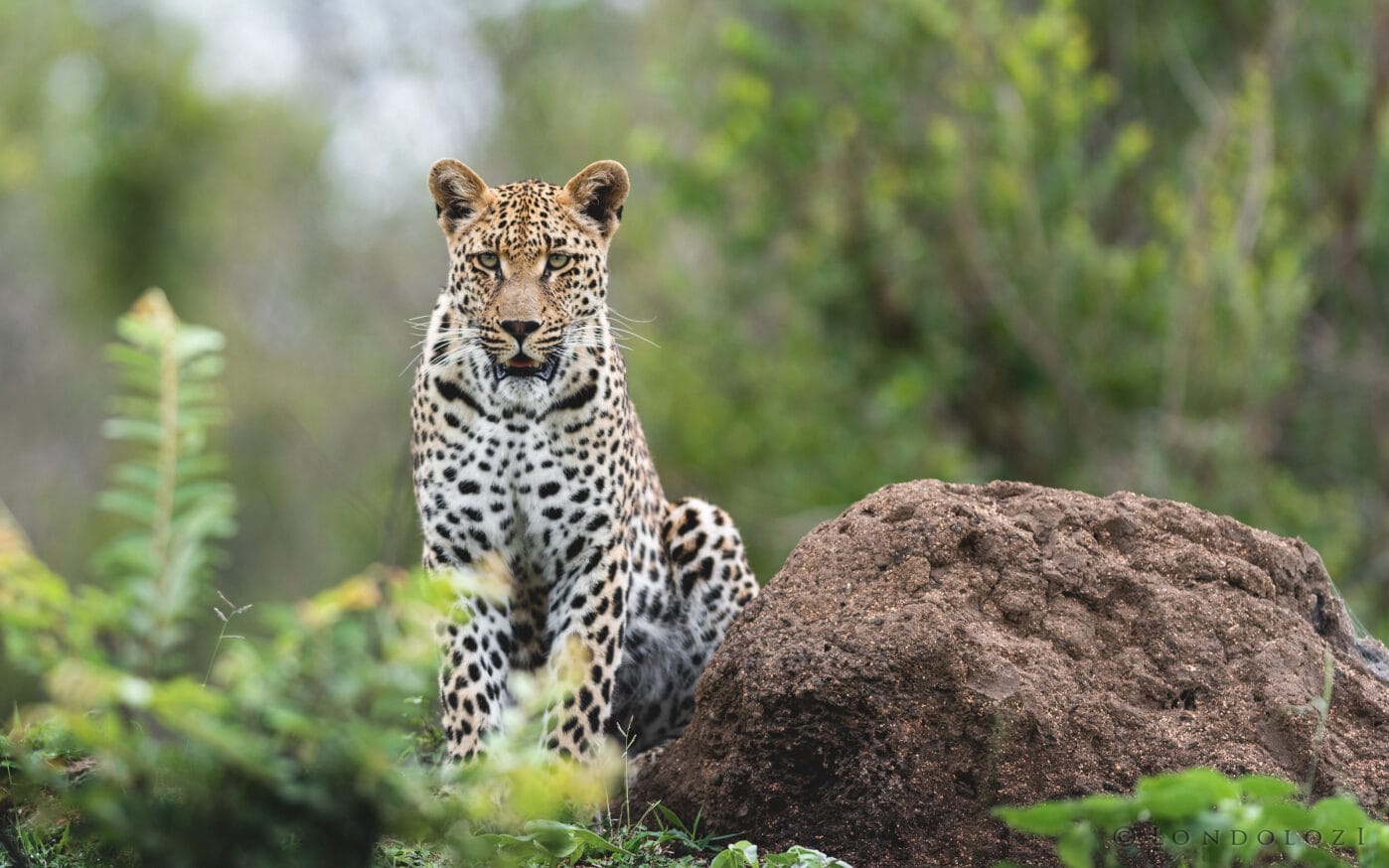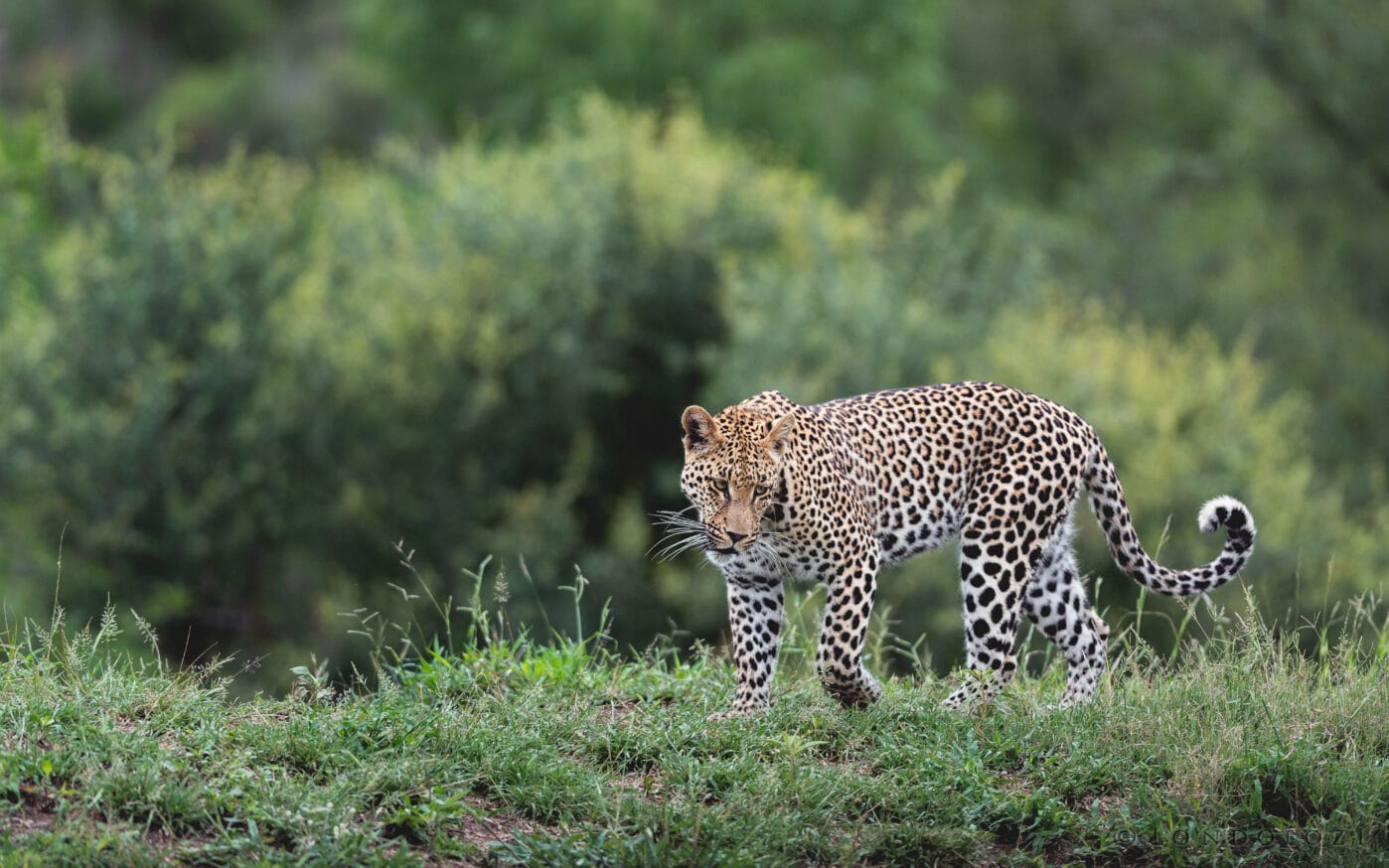Over the last couple of months there have been a handful of sightings of a young male leopard in the southern most reaches of Londolozi. Rangers and trackers are quite excited about the prospects of yet another new young male leopard roaming the reserve. Albeit not originally from the Londolozi area, I’ll bring to light a little bit more information about his background and journey thus far.
He is officially known as the Nottens 4:4 Male. Those of you who know the leopards of Londolozi quite well might have even been able to guess who his father is after having seen him featured in my latest TWIP. This young male is a spitting image of his father, the Nweti Male. For his age, at almost 3 years old, he is also a relatively large individual. We suspect that because of this, he will not have any trouble in becoming a successful territorial male down the line. Other males such as the Misava Male have not been as fortunate.
His mother is the Ntsumi Female, who we occasionally see from time to time. Mainly viewed when she’s on a territorial patrol, demarcating the most northern extent of her territory. The Nottens Male has spent most of his life thus far south of our southern boundary, so he was never viewed on Londolozi whilst growing up. As far as we know, the Nottens Male did have a female litter-mate, but unfortunately as is the case with most young leopards, she did not make it.
What’s quite interesting is that he was forced into a relatively early independence by his mother. Normally male leopards will stay with their mothers for about 2 years before starting to venture off on their own. The Ntsumi Female currently has 2 cubs that are about 7 months old already. This means that the Nottens Male would have had to learn to fend for himself a little earlier than most males.
We’ve seen the Ntomi Male staying within the Senegal Bush Male’s territory, his father, for an extra layer of safety. The Nottens Male who is only a little younger, is doing the same with his father, the Nweti Male. Young nomadic males will quite literally follow in the footsteps of their fathers, keeping ‘hot on their heels’ as it were. If he stays within the near vicinity of his father, he’s less likely to be in danger from another larger male.
The Nweti Male has a powerful presence throughout his enormous territory. As his rasps ripple through the landscape in the still of the night, other males who are foreign to the area will know to stay clear or else be faced with danger. This is what will allow the Nottens Male to venture beyond his mother’s territory that he knows so well, and become accustomed to a new, larger area where he can explore and expand his horizons. This means that we can expect to come across the Nottens Male anywhere within the Nweti Male’s territory, aside from its very outskirts.
Although the thought of him staying around long-term is very exciting, the density of male leopards is very high at the moment and we believe that he will disperse further afield. He is still too young to pose a challenge to any of the bigger males around the area. It’s always incredibly exciting nonetheless, and because this particular male is so beautiful and supremely relaxed like his father, he will certainly be providing some good leopard viewing down in the southern parts of Londolozi.
We will definitely put out some more updates on him if he does decide to stay around a little longer than we expect. Speaking of which, this has turned out to be the case with the Kangela Male. Stay tuned for an update coming up about him in the coming weeks.





















Hi Matt, is Nottens the name of the area he has come from? If so, guess that was the case for the Nottens female, who I think still holds the record for the oldest leopard on Londolozi when she died at 17?
Great news, Matt. He is indeed a very beautiful young leopard.
By the way, how do these young leopards “know” who their father is? Is it because a male leopard kind of accepts his own offspring? But how does he know who his sons or daughters are? The ladies seem to mate with several males, don’t they, so that everybody thinks the cubs are theirs.
Super photos and interesting back story, this blog is one of the things that is so special about Londolozi , th culture of photography and the knowledge of the backgrounds of the animals they are photographing
Hi Matt, the Nottens male is quite a stunning specimen and yes he certainly does look like his father the Nweti male. He is very clever staying close to his dad for protection and learning to be independent. Usually the male cubs stay with their mother for 2 years, but you say he was forced to independence much earlier than usual. Please keep us to date with this beautiful specimen and also the Ntomi males escapades please.
Matt, it will be fascinating to watch the Nottens male as he matures. Thank you for sharing this information .
How exciting! Tho I hope no fighting! It is amazing how different they look once you get to know them. And he really does look like his dad doesn’t he?! The Ntomi male favors his mum I think 🙂
This is exciting news Matt! Nottens is a stunning male, in part due to his lineage. Both his mother and father are notable leopards within SabiSabi: Ntsumi has successfully raised Golyoni female as well as Nottens, and her daughters at 7 months, could also add to her story as one of the impressive mothers of SabiSands, and Nweti, given his size and power is the most formidable male in his territory. I saw Nottens almost a year ago, recently pushed away by his mother, but still following her around and when she wasn’t looking, he’d sneak in to feed on her kill. As you stated, it would be nice to see him more frequently, but given the established male leopards within the Londolozi borders, it probably won’t happen. After all Ntomi is still around! Thanks for the update.
These are among some of the most welcomed news, a new leopard around! It’s not only because their intriguing, complex behaviour, but also as they’re so important to contribute to keep the leopard population healthy. And they are the most beautiful animals around!
The Nottens Male is an incredible combination of youth, power, and unrivaled beauty. The pattern of spots on the hind legs are breathtaking. The lineage is very interesting.